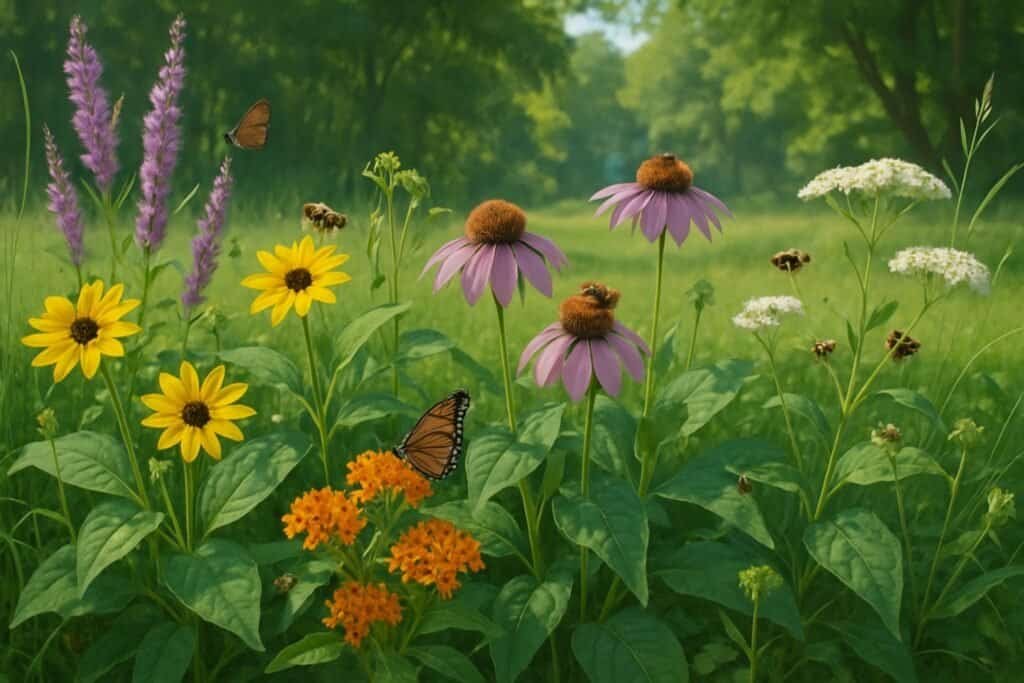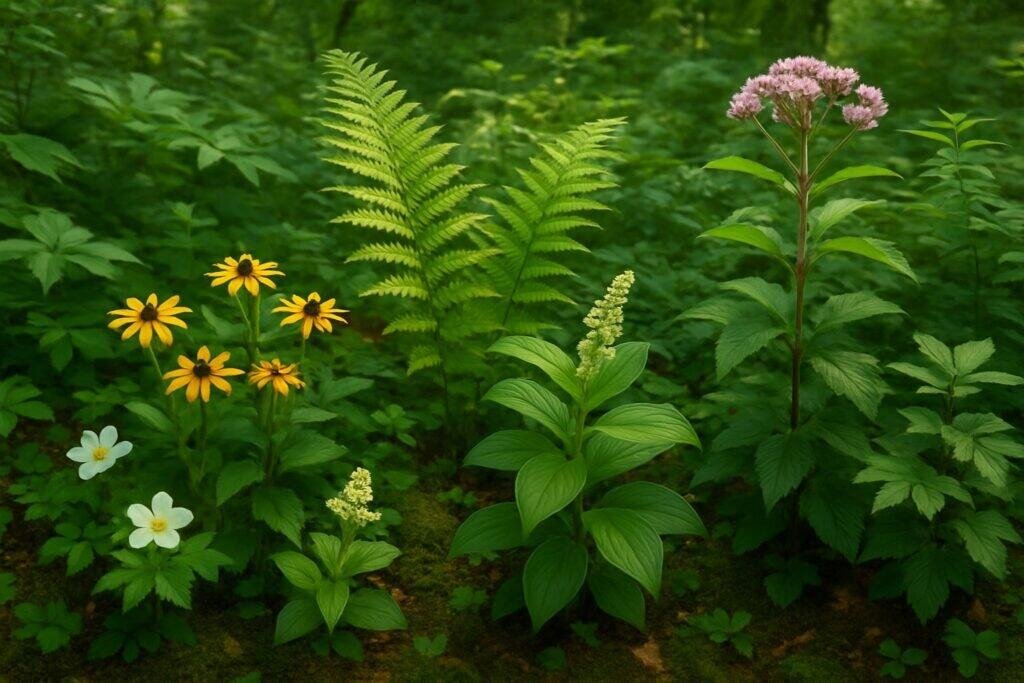Native plants form the foundation of healthy ecosystems in our communities. These plants have evolved in specific regions over thousands of years, developing relationships with local wildlife, soil microbes, and climate conditions.
Native plants support local ecosystems by providing food and habitat for wildlife, conserving water, and requiring less maintenance than non-native species.
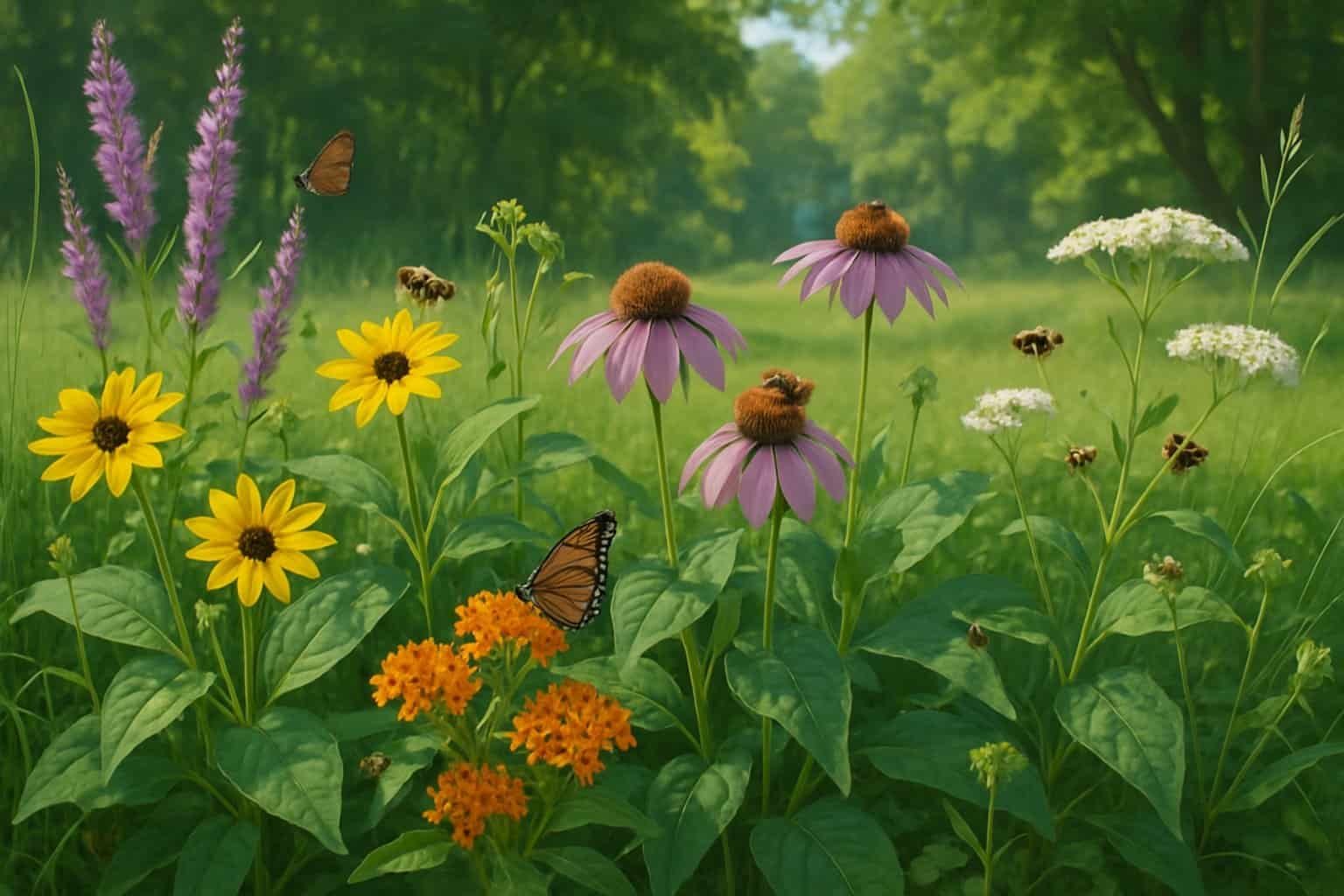
When you choose native plants for your garden or landscape, you do more than create beautiful spaces. You help restore biodiversity, support pollinators like bees and butterflies, and build resilient environments that withstand climate challenges.
Native plants have deep root systems that prevent erosion and filter water. This improves the health of local watersheds.
Key Takeaways
- Native plants support local wildlife by providing essential food and habitat that non-native plants often cannot offer.
- Using native species in landscapes reduces the need for water, fertilizers, and pesticides while helping to combat invasive species.
- Native plant gardens strengthen ecosystem resilience against climate change while creating connections to local natural heritage.
The Ecological Role of Native Plants
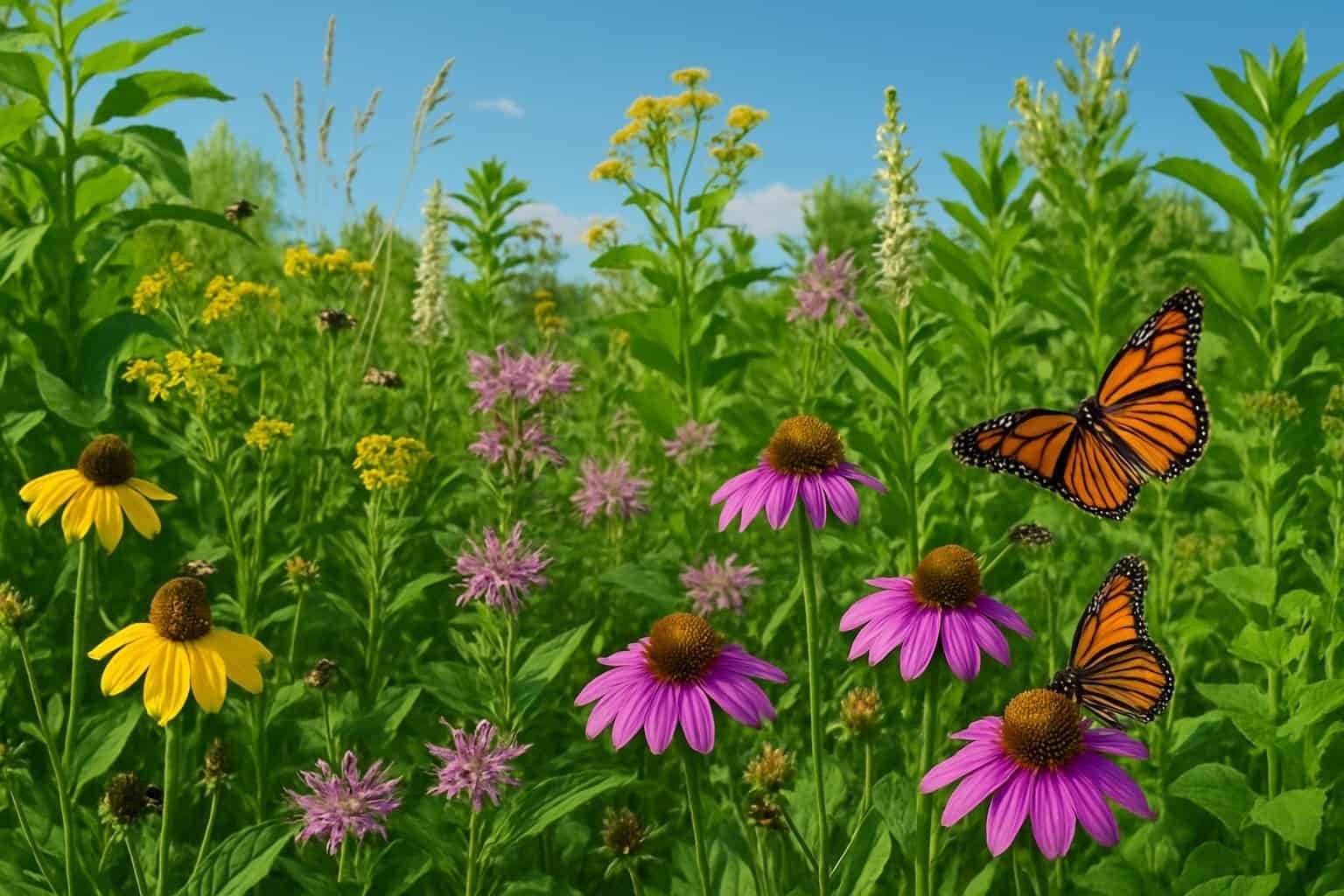
Native plants form the backbone of local ecosystems. They have evolved alongside other species in their regions for thousands of years, creating complex relationships that support wildlife and maintain environmental health.
Supporting Healthy Ecosystems
Native plants are adapted to local soil conditions, rainfall patterns, and temperatures. They require less water and fewer resources to thrive.
Native plants develop deep root systems that prevent soil erosion and improve water quality by filtering runoff. They also participate in nutrient cycling.
When native plant leaves and stems decompose, they return essential nutrients to the soil. This creates a balanced system where resources are used efficiently.
Native plants form the foundation of food webs. They produce nectar, pollen, nuts, seeds, and fruits that feed insects, birds, and other wildlife.
Enhancing Biodiversity
Native plant species support more wildlife than non-native alternatives. Research shows native oak trees can support over 500 species of caterpillars, while non-native trees might support fewer than 10.
These plants offer specialized food and shelter that local wildlife depends on. Many insects eat only specific native plants—monarch butterfly caterpillars feed exclusively on milkweed.
Native plants also maintain genetic diversity within ecosystems. Different populations of the same species may have unique genetic adaptations to micro-conditions in a region.
This diversity creates resilience. If one species struggles due to disease or weather, others can fulfill similar ecological functions.
Resilience to Local Climate
Native plants have adapted to local weather patterns over thousands of years. They can withstand regional temperature extremes, seasonal changes, and precipitation patterns without extra support.
During drought, established native plants often survive while non-natives struggle. Their deep roots help them access water sources other plants cannot reach.
Native ecosystems recover more quickly from disturbances like fires or floods. Many native species have evolved specific adaptations to these events.
Some native seeds even require fire to germinate. As climate change brings more extreme weather, native plant communities buffer against these impacts.
Their relationships with soil microbes, pollinators, and other plants create systems that adapt to gradual changes better than introduced species.
Providing Wildlife Habitat and Food
Native plants provide critical habitat and food resources for wildlife. These plants have evolved alongside local animals for thousands of years, creating interdependent relationships.
Shelter and Nesting Sites
Native trees, shrubs, and grasses offer ideal shelter for wildlife throughout the year. Birds build nests in native trees that match their needs for height, branch structure, and coverage.
Rabbits and small mammals find protection in dense native shrubs that shield them from predators. Native grasses provide ground cover where deer can bed down and smaller creatures can hide.
These plants create natural cavities and spaces wildlife depends on. Even dead native trees offer homes for woodpeckers, owls, and various cavity-nesting species.
Many native wildlife species are highly specialized in their habitat requirements and cannot adapt to non-native alternatives.
Food Sources for Birds and Mammals
Native plants produce berries, nuts, and seeds that match local wildlife feeding patterns. Unlike ornamental plants bred for appearance, native species offer:
- Berries: Appear at the right times when birds need them most
- Nuts and seeds: Contain nutrients local species require
- Foliage: Digestible by native browsers like deer and rabbits
The nutritional content of native plant foods is higher than non-native alternatives. For example, native oak trees support over 500 caterpillar species, which become food for birds.
Native fruit-bearing shrubs like serviceberry and elderberry provide energy for migrating birds. These food sources are especially important during breeding seasons.
Host Plants for Insects and Caterpillars
Many insects can only complete their life cycles on specific native plants. Monarch butterflies require milkweed to lay their eggs, as it’s the only plant their caterpillars can eat.
Native insects have evolved mouthparts and digestive systems that work with native plant chemistry. The relationship is so specific that:
- 90% of plant-eating insects can only develop on plants they’ve evolved with
- Many butterfly and moth species use only one plant genus as hosts
- Native bees collect pollen from specific native flowers with matching bloom times
These insects form the base of the food web, feeding birds, mammals, and other wildlife. A pair of chickadees needs thousands of caterpillars to raise one brood of young.
When native plants disappear, entire insect populations collapse. This disrupts the food web above them.
Native Plants and Pollinator Conservation
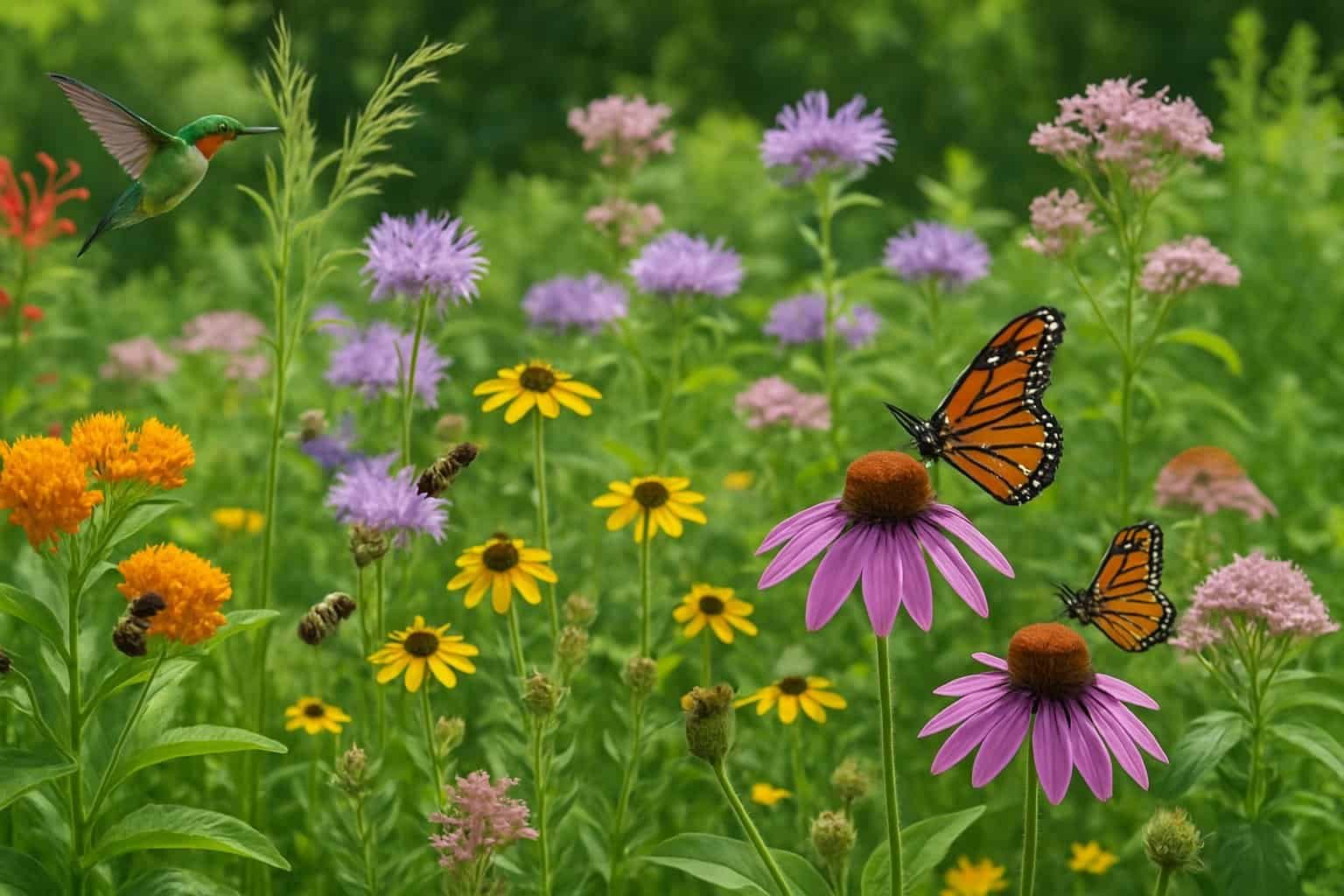
Native plants play a crucial role in supporting local pollinator populations. Plants and their pollinators have developed specialized relationships over thousands of years.
Attracting Bees and Butterflies
Native bees and butterflies are naturally drawn to native plants. These pollinators recognize the flowers, shapes, and scents they’ve adapted to over generations.
Many native bees are specialists and collect pollen from only certain plant species or families. Black-eyed Susans, coneflowers, and asters attract a wide variety of native bees.
Monarch butterflies specifically need milkweed for their caterpillars. No other plant will do.
Gardens with at least 70% native plants support more pollinator species than non-native gardens. Native plants also bloom at different times, providing consistent food sources for pollinators.
Supplying Pollen and Nectar
Native plants produce pollen and nectar in quantities and qualities that match the needs of local pollinators. Non-native or hybrid plants do not always provide these resources.
Some hybrid flowers have been bred for appearance rather than pollen or nectar production. Many have complex flower structures that make accessing nectar difficult for native pollinators.
Native species like bee balm, goldenrod, and native sunflowers produce abundant nectar high in the sugars pollinators need. Their pollen contains proteins and fats essential for reproduction and larval development.
The timing of nectar and pollen availability from native plants aligns with pollinator life cycles. This ensures resources are available when pollinators most need them.
Creating Pollinator-Friendly Gardens
Designing a pollinator-friendly garden starts with choosing native plants for your region. Local native plant societies and extension offices can provide lists of species suited to your area.
Key elements of a pollinator garden:
- Variety of native flowering plants that bloom throughout the growing season
- Clusters of the same plant species (at least 3-5 plants) to make foraging easier
- Shallow water sources with landing spots
- Limited or no pesticide use
- Undisturbed areas for nesting and overwintering
Adding host plants like native grasses and shrubs gives caterpillars places to feed and grow. Leaving leaf litter and bare soil patches provides nesting sites for ground-dwelling native bees.
Even small gardens can make a difference. A collection of native plants in containers on a balcony can serve as a “pollinator pit stop” in urban environments.
Soil Health, Water Management, and Air Quality
Native plants contribute to environmental health through their interactions with soil, water, and air. Their adaptations to local conditions create ecological benefits that introduced species often cannot match.
Deep Root Systems and Soil Stability
Native plants grow extensive root systems that reach deep into the ground. These roots can extend several feet below the surface, holding soil particles together and preventing erosion.
During heavy rainfall, these root structures maintain soil integrity even on slopes and hillsides. Many prairie grasses have roots extending 8-15 feet downward, while typical lawn grass roots reach only 2-3 inches.
Deep roots increase soil porosity, allowing better water infiltration and creating channels for beneficial microorganisms. This improved soil structure helps break down organic matter more efficiently.
Native plant roots store carbon compounds underground, often for decades. This process builds healthier soils with higher organic content and greater nutrient availability.
Reducing Water Runoff and Conserving Water
Native plants excel at water management because they adapt to local rainfall patterns. Their efficient water usage reduces the need for irrigation once established.
In urban areas, native plant gardens can capture and filter up to 90% of rainwater runoff from roofs and driveways. This reduces pressure on stormwater systems and helps recharge groundwater.
Many native species have adaptations for conserving water, such as waxy leaf coatings, smaller leaf surfaces, and seasonal dormancy during dry periods.
By slowing water movement across landscapes, native plants help prevent flooding and reduce contamination of waterways. This natural filtration removes pollutants before they reach streams and rivers.
Improving Air Quality and Oxygen Production
Native plants improve air quality through several mechanisms. Their leaves capture airborne particles, including dust and pollutants, which rain washes to the ground.
Areas with diverse native vegetation can reduce particulate matter by 7-24% compared to areas with little plant cover. This filtering effect is especially valuable in urban environments.
Native plant communities produce substantial amounts of oxygen. A single mature native tree can produce enough oxygen for two to four people daily.
Native plants reduce air pollution by minimizing the need for gas-powered maintenance equipment. Unlike many non-native ornamentals, they require less pruning, mowing, and chemical treatments.
Their adaptation to local environments means native plants efficiently absorb and process carbon dioxide. This helps mitigate climate change impacts through carbon storage above and below ground.
Landscape Advantages and Low Maintenance Benefits
Native plants offer practical benefits for any garden or landscape. They thrive with minimal intervention and create beautiful, sustainable spaces that change with the seasons.
Adaptation to Local Soil and Climate
Native plants have evolved over thousands of years to flourish in their regional environments. This natural adaptation means they’ve developed ways to survive in local soils, whether sandy, clay-based, or rocky.
Native trees and shrubs grow deeper root systems than non-native species. These roots help them access water during dry periods and reduce the need for extra watering once established.
In coastal areas, native plants tolerate salt spray and sandy soils. In mountain regions, they withstand temperature swings and harsh winters without special care.
Native plant gardens use up to 80% less water than conventional landscapes after becoming established. This makes them resilient during droughts when water restrictions apply.
Reduced Need for Fertilizers and Pesticides
Native plants usually need no extra fertilizers once established. They extract nutrients efficiently from local soils, even if the soil seems poor.
Landscaping with native plants creates a balanced ecosystem that naturally deters pests. Native species have developed their own defenses against local insects, so gardeners rarely need chemical pesticides.
When pest issues occur, they tend to be less severe in native gardens. The diversity of native plants prevents diseases from spreading quickly.
- Benefits of reduced chemical use:
- Lower maintenance costs
- Protection of local water quality
- Safer environment for children and pets
- Support for beneficial insects like pollinators
Sustaining Beauty Throughout the Seasons
Native landscapes offer year-round visual interest as plants follow natural cycles. Spring brings wildflowers, summer shows greenery, fall offers vibrant foliage, and winter reveals unique seed heads and bark.
This seasonal change creates dynamic beauty throughout the year. Many native perennials bloom longer than high-maintenance exotic plants.
Native grasses add movement and texture, providing interest even in winter when their seed heads catch snow or frost.
Native plants maintain their vigor through changing conditions without constant care. They don’t decline suddenly after a short show like many exotic plants.
A well-designed native garden includes species that bloom in succession. This ensures continuous color and food for wildlife across the seasons.
Combating Invasive Species and Supporting Conservation
Native plants help maintain ecological balance by resisting invasive species and supporting conservation. They have evolved alongside local wildlife, creating ecosystems that preserve biodiversity.
Limiting the Spread of Invasive Plants
Invasive plants often outcompete native species because they lack natural predators or diseases. Choosing native plants helps prevent invasive species from taking over local ecosystems.
Native plants create barriers that slow the spread of invasives. They fill ecological niches that might otherwise be taken by non-native plants.
Areas with strong native plant populations resist invasion better. For example, prairie restorations with diverse native species have up to 60% fewer invasive plants than disturbed areas.
Many invasive plants, like kudzu and purple loosestrife, cause billions in damage each year. Native plants help reduce these costs and preserve habitats.
Promoting Conservation Efforts
Conservation groups focus on native plant restoration as a key strategy. These efforts help rebuild wildlife habitats that have been lost or damaged.
Even small native plant gardens serve as conservation hubs. They provide resources for pollinators and connect larger natural areas.
Many endangered plants are natives that have lost habitat to development or invasives. By growing these plants, gardeners help preserve species.
Native plant nurseries often collect seeds ethically from wild populations. This practice maintains genetic diversity and provides gardeners with locally adapted plants.
Preserving Local Ecoregions
Each ecoregion has unique plant communities that have developed over thousands of years. These communities form the base of local food webs and ecosystem services.
Native plants help keep the distinct character of different ecoregions. Desert plants in Arizona differ from woodland species in New England, each supporting specialized wildlife.
Climate change threatens many ecoregions, but native plants improve resilience. Their deep roots prevent erosion, capture carbon, and withstand extreme weather better than many non-natives.
Local ecoregions face threats from development, pollution, and habitat loss. Preserving native plants offers a practical way to protect unique natural heritage.
Native Plants and Climate Change Resilience
Native plants help ecosystems respond to climate change. They have evolved strategies over thousands of years that make them well-suited to handle environmental shifts in their local regions.
Adapting to Changing Environmental Conditions
Native plants have genetic adaptations to local climate extremes. Many species grow deep roots that reach water during droughts, sometimes extending 15-20 feet underground.
During unusual weather, native plants show strong resilience. Prairie grasses, for example, survive both flooding and drought in the same year.
Native plant communities create microhabitats that buffer temperature extremes. Shade from native trees can cool areas by 10-15°F, offering wildlife refuge during heat waves.
As temperatures rise, native plant ranges shift naturally. Many species are already moving to higher elevations or latitudes in response to climate change.
Supporting Carbon Sequestration
Native plants capture and store carbon dioxide from the air. Prairies and meadows with native grasses store carbon mainly in their deep root systems.
Native grasslands can store up to 5 tons of carbon per acre each year. This carbon stays underground even after aboveground parts die back.
Native forests offer even greater carbon benefits. Mature woodlands can store over 100 tons of carbon per acre in trees, understory plants, and soil.
Soil networks formed by native plants are important for carbon storage. Mycorrhizal fungi with native roots move carbon deep into the soil, where it stays for decades or centuries.
Propagation and Community Engagement
Growing and sharing native plants supports ecological restoration. Collecting seeds and involving communities spreads these beneficial plants to more landscapes.
Seed Collection and Planting
Collecting seeds from native plants is rewarding and affordable. The best time is when seeds are fully mature but before they disperse.
Most native seeds need specific conditions to germinate. Some require cold stratification—exposure to cold and moisture for weeks. Others need scarification—lightly damaging the seed coat to let water in.
Match native seeds with the right growing conditions. Consider soil type, pH, light, moisture, and space for mature growth.
Many native plants grow more slowly than non-natives but develop stronger roots. This patience results in plants that need less care once established.
Involving Communities in Native Plant Initiatives
Community engagement boosts native plant restoration. Schools, neighborhoods, and groups can work together to transform public spaces with native species.
Plant swaps let gardeners exchange native plants, spreading diversity. These events connect experienced gardeners with beginners.
Educational workshops teach people how to identify native plants, understand their benefits, cultivate them, and find resources for seeds and plants.
Community native plant gardens serve as living classrooms. They show the beauty of native plants and teach about their importance.
Volunteer programs for seed collection and habitat restoration build skills and achieve meaningful results. These activities foster stewardship and connect people to local landscapes.
Frequently Asked Questions
Native plants offer many benefits to local ecosystems. They support ecosystem stability, help wildlife, improve soil health, conserve water, and boost biodiversity.
How do native plants contribute to ecosystem stability?
Native plants have evolved in local conditions over thousands of years. They develop natural defenses against local pests and diseases.
Their deep roots help prevent soil erosion. During heavy rains or floods, these roots hold soil in place.
Native plant communities recover quickly from disturbances like fires or storms. This resilience helps maintain balance even in tough times.
What roles do native plants play in supporting local wildlife?
Native plants provide essential food for local wildlife. They produce nectar, pollen, fruits, and seeds that meet the needs of native animals.
Many wildlife species have co-evolved with native plants. Monarch butterflies, for example, rely on milkweed to complete their life cycle.
Native plants also offer good shelter and nesting sites. Birds use native trees and shrubs for nesting and protection.
In what ways do native plants benefit soil health?
Native plants grow extensive root systems that add organic matter to soil as they grow and die back. This naturally increases soil fertility.
They form helpful relationships with soil microorganisms. These partnerships help plants access nutrients and improve soil structure.
Native plant communities create diverse soil ecosystems. Different root depths and structures provide habitat for soil organisms like bacteria and earthworms.
How do native plant species influence water conservation?
Native plants usually need less watering than non-native species. They adapt to local rainfall and thrive without extra irrigation.
Their deep roots help rainwater soak into the soil instead of running off. This reduces water waste and refills groundwater.
Many native species survive droughts. Their water efficiency helps conserve resources during dry periods.
What are the ecological impacts of replacing native plants with non-native species?
Non-native plants often lack natural predators, so they spread unchecked. This can let invasive species outcompete native plants.
Wildlife that relies on native plants may decline if their food sources disappear. This causes a domino effect in the food web.
Some non-native plants change soil chemistry or structure. These changes can make it hard for native species to return.
How can the cultivation of native plants promote biodiversity?
Native plants support specialized pollinators that cannot use non-native plants. More plant diversity attracts a wider variety of pollinators.
Different native species provide habitat for many animals. A yard with several native plant species supports more wildlife than one with only non-natives.
Native plant gardens act as stepping stones between natural areas. These connections help wildlife move safely through developed landscapes.

